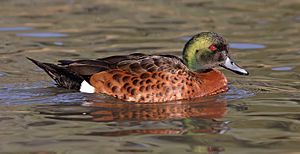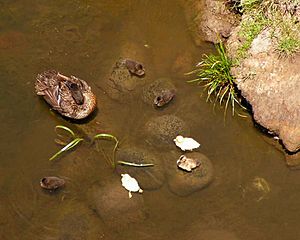Chestnut teal facts for kids
Quick facts for kids Chestnut teal |
|
|---|---|
 |
|
| Male | |
 |
|
| Female | |
| Conservation status | |
| Scientific classification | |
| Genus: |
Anas
|
| Species: |
castanea
|
The chestnut teal (Anas castanea) is a type of dabbling duck that lives in Australia. These ducks are protected by law under the National Parks and Wildlife Act 1974.
Contents
About the Chestnut Teal's Name
Every living thing has a scientific name, like a special code. The chestnut teal was first described by an English scientist named Thomas Campbell Eyton in 1838. He gave it the name Mareca castanea.
The word castanea comes from Latin. It means "chestnut-coloured" or "chestnut-brown." This name perfectly describes the duck's feathers.
Scientists have also studied the DNA of ducks, geese, and swans. They found that the chestnut teal is closely related to the Sunda teal. The Sunda teal is a duck found only in Indonesia.
What Does a Chestnut Teal Look Like?
The chestnut teal is a bit darker and slightly bigger than the grey teal. It's easy to tell them apart if you know what to look for!
Male Chestnut Teals
Male chestnut teals are quite striking. They have a bright green head that really stands out. Their body is a mix of brown colours, giving them a mottled, or spotted, look.
Female Chestnut Teals
Female chestnut teals have a brown head. Their body also has a mottled brown pattern. Females look very similar to the grey teal, which can make them tricky to identify.
Sounds They Make
If you hear a loud, fast quack, it might be a female chestnut teal! They make a strong, "laughing" quack. They often repeat this sound quickly nine or more times.
Where Do Chestnut Teals Live?
Chestnut teals are common in south-eastern and south-western Australia. You might also see them in other places, but less often. Tasmania and southern Victoria are places where many chestnut teals live.
Sometimes, these ducks travel far from home. They have been seen as far north as New Guinea and Lord Howe Island. They have also been spotted as far south as New Zealand.
Their Favorite Homes
These ducks love to live near the coast. They prefer places like estuaries (where rivers meet the sea) and wetlands. They don't mind if the water is salty or fresh.
What They Eat
Chestnut teals are omnivores. This means they eat both plants and animals. They find their food in the water and along the shore.
How Chestnut Teals Raise Their Young
Chestnut teals form pairs that stay together for a long time. They are known as monogamous birds. This means one male and one female stay together, even when it's not breeding season.
Nesting Habits
When it's time to have babies, the pair works together. They defend their nest site from other birds. They also look after their ducklings once they hatch.
Nests are usually built over water. They often choose a hollow in a tree, about 6 to 10 metres high. The inside of the nest is lined with soft down feathers. Sometimes, they build nests on the ground. These ground nests are usually hidden among clumps of grass near water.
Newborn Ducklings
Once the young ducklings hatch, they are ready for action! Within a day, they can swim and walk. This helps them find food and stay safe very quickly.
See also
 In Spanish: Cerceta castaña para niños
In Spanish: Cerceta castaña para niños



